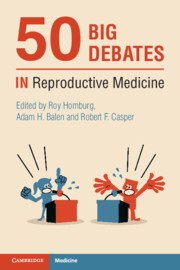Book contents
- 50 Big Debates in Reproductive Medicine
- Series page
- 50 Big Debates in Reproductive Medicine
- Copyright page
- Contents
- Contributors
- Foreword
- Introduction
- Section I Limits for IVF
- Section II IVF Add-ons
- Section III The Best Policy
- Section IV Embryology
- Section V Ethics and Statistics
- Section VI Male-factor Infertility
- Section VII Genetics
- Section VIII Ovarian Stimulation
- 41A AMH Is a Better Predictor of Ovarian Response Than AFC
- 41B AMH Is a Better Predictor of Ovarian Response Than AFC
- 42A Pituitary Suppression Using GnRH Agonist for IVF Is Outdated
- 42B Pituitary Suppression Using GnRH Agonist for IVF Is Outdated
- 43A The Maximum Effective Dose of FSH for Ovarian Stimulation in IVF Is 300 IU
- 43B The Maximum Effective Dose of FSH for Ovarian Stimulation in IVF Is 300 IU
- 44A There Is No Place for Natural and Mild Stimulation IVF
- 44B There Is No Place for Natural and Mild Stimulation IVF
- Section IX Hormones and the Environment
- Index
- References
42B - Pituitary Suppression Using GnRH Agonist for IVF Is Outdated
Against
from Section VIII - Ovarian Stimulation
Published online by Cambridge University Press: 25 November 2021
- 50 Big Debates in Reproductive Medicine
- Series page
- 50 Big Debates in Reproductive Medicine
- Copyright page
- Contents
- Contributors
- Foreword
- Introduction
- Section I Limits for IVF
- Section II IVF Add-ons
- Section III The Best Policy
- Section IV Embryology
- Section V Ethics and Statistics
- Section VI Male-factor Infertility
- Section VII Genetics
- Section VIII Ovarian Stimulation
- 41A AMH Is a Better Predictor of Ovarian Response Than AFC
- 41B AMH Is a Better Predictor of Ovarian Response Than AFC
- 42A Pituitary Suppression Using GnRH Agonist for IVF Is Outdated
- 42B Pituitary Suppression Using GnRH Agonist for IVF Is Outdated
- 43A The Maximum Effective Dose of FSH for Ovarian Stimulation in IVF Is 300 IU
- 43B The Maximum Effective Dose of FSH for Ovarian Stimulation in IVF Is 300 IU
- 44A There Is No Place for Natural and Mild Stimulation IVF
- 44B There Is No Place for Natural and Mild Stimulation IVF
- Section IX Hormones and the Environment
- Index
- References
Summary
What is the principle? The aim of the treatment with either the agonist or the antagonist is to prevent premature luteinisation. And the idea that immediate blockade with a GnRH antagonist should be simple, safe and versatile compared to the complex road the agonist has to take via desensitisation is highly valid and understandable. So do both drugs do what they promise and to the same extent? The answer is no, as elegantly demonstrated in an analysis by Kolibianakis, which shows that daily agonist yielded less than 1% of cycles premature LH secretion against 8% with antagonist (1). Remarkably many LH rises occurred before the antagonist treatment was even started.
- Type
- Chapter
- Information
- 50 Big Debates in Reproductive Medicine , pp. 219 - 221Publisher: Cambridge University PressPrint publication year: 2021



